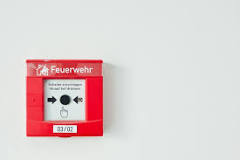Fire alarms play a crucial role in ensuring the safety and security of buildings and occupants in the event of a fire emergency. These alarm systems are designed to detect the presence of smoke, heat, or flames and alert individuals to evacuate the premises promptly. The use of fire alarms is essential in both residential and commercial settings to minimize the risk of property damage and prevent injuries or fatalities.
One of the primary functions of a fire alarm system is early detection. By promptly detecting signs of a fire, such as smoke or heat, fire alarms provide occupants with valuable time to evacuate the building safely. This early warning can make a significant difference in preventing the spread of fire and reducing potential harm to individuals within the premises.
Moreover, fire alarms are equipped with loud audible alerts, such as sirens or bells, that are designed to grab people’s attention and prompt them to take immediate action. In addition to audible alerts, modern fire alarm systems may also include visual indicators, such as flashing lights or LED displays, to ensure that individuals with hearing impairments can also be alerted in case of an emergency.
Fire alarms are typically interconnected with other safety systems, such as sprinklers and emergency lighting, to provide comprehensive protection in the event of a fire. When a fire alarm is triggered, it can automatically activate these additional safety measures to help contain the fire and facilitate safe evacuation procedures.
Regular maintenance and testing of fire alarm systems are essential to ensure their proper functioning when needed. Building owners and facility managers should schedule routine inspections by qualified technicians to check for any faults or malfunctions in the system. It is also important to conduct periodic drills and training sessions for occupants to familiarize them with evacuation procedures and the sound of the fire alarm.
In conclusion, the use of fire alarms is critical for enhancing overall safety measures in buildings and minimizing the impact of fires on property and lives. By investing in reliable fire alarm systems and ensuring their proper maintenance, property owners can create a safer environment for occupants and reduce the risks associated with fire emergencies.
Essential Fire Alarm Safety Tips for Your Home or Building
- Install fire alarms in key areas of your home or building.
- Test your fire alarms regularly to ensure they are functioning properly.
- Replace the batteries in your fire alarms at least once a year.
- Create and practice a fire escape plan with all occupants of the building.
- In case of a fire alarm, evacuate immediately and call emergency services.
Install fire alarms in key areas of your home or building.
It is crucial to install fire alarms in key areas of your home or building to ensure comprehensive coverage and early detection of potential fire hazards. By strategically placing fire alarms in critical locations, such as bedrooms, hallways, kitchens, and near heating appliances, you can maximize the effectiveness of the alarm system in alerting occupants to evacuate promptly in case of a fire emergency. This proactive measure helps to enhance overall safety and provides occupants with valuable time to respond quickly and efficiently to mitigate the risks associated with fires.
Test your fire alarms regularly to ensure they are functioning properly.
Testing your fire alarms regularly is a crucial safety measure to ensure they are functioning properly and can provide early warning in the event of a fire emergency. By conducting routine tests, you can verify that the alarm system is operational and capable of alerting occupants promptly. This proactive approach helps to identify any potential issues or malfunctions in the system, allowing for timely maintenance or repairs to be carried out. Regular testing of fire alarms not only enhances the overall safety of the building but also instills confidence in occupants that appropriate measures are in place to protect their well-being.
Replace the batteries in your fire alarms at least once a year.
It is crucial to replace the batteries in your fire alarms at least once a year to ensure their reliable operation in case of a fire emergency. By regularly changing the batteries, you can maintain the effectiveness of your fire alarm system and avoid the risk of battery failure during a critical situation. This simple yet essential maintenance tip can make a significant difference in providing early warning and protection for occupants in the event of a fire, ultimately contributing to a safer living or working environment.
Create and practice a fire escape plan with all occupants of the building.
Creating and practicing a fire escape plan with all occupants of the building is a crucial tip for maximizing the effectiveness of fire alarms. By developing a detailed escape plan that outlines evacuation routes, assembly points, and designated responsibilities, occupants can respond quickly and efficiently in the event of a fire emergency. Regular practice drills help familiarize everyone with the escape plan and the sound of the fire alarm, ensuring a coordinated and orderly evacuation process. By involving all occupants in the preparation and practice of a fire escape plan, the chances of a safe and successful evacuation are significantly increased, ultimately enhancing overall safety measures within the building.
In case of a fire alarm, evacuate immediately and call emergency services.
When a fire alarm is activated, it is crucial to prioritize safety above all else. In the event of a fire alarm, it is imperative to evacuate the building immediately and call emergency services without delay. Every second counts in such situations, and swift action can make a significant difference in ensuring the well-being of individuals and minimizing the impact of the fire. Remember that property can be replaced, but lives cannot. Evacuating promptly and seeking professional help by contacting emergency services is the best course of action to safeguard yourself and others during a fire emergency.




